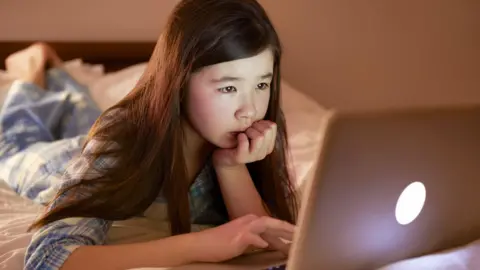Technology Reporter
 Getty Images
Getty ImagesMore than 80% of Australian children aged eight to 12 use social media or messaging services that are only meant to be for over-13s, according to new research.
It comes as Australia plans to implement a total social media ban for under-16s that is expected by the end of this year.
The country’s internet regulator, eSafety, found YouTube, TikTok and Snapchat were the most popular platforms used by young children.
The regulator accused the apps of “a lack of robust interventions” for checking the ages of their users.
The companies in question – Discord, Google (YouTube), Meta (Facebook and Instagram), Reddit, Snap and Twitch – did not immediately respond to a request for comment.
Users of all of these platforms must be 13 and over to have an account, though there are some exceptions.
For example, YouTube has Family Link – when an account is accessible for children under the age of 13 under the supervision of a guardian – and the separate app YouTube Kids, which is specifically made for children.
In the report, usage of YouTube Kids was not included for this reason.
It has been reported that YouTube is likely to be spared from the social media ban when it comes into force.
“The findings of this report will be a helpful input to guide next steps,” said eSafety commissioner Julie Inman Grant.
Australia’s robust stance on social media for young people is being keenly watched by the rest of the world – including the UK which has not ruled out copying its ban for young users.
In its response to the study, TikTok took the opportunity to criticise the Australian authorities over its stance on YouTube. “This report again shines a spotlight on the government’s decision to give an exclusive carve out to the most popular social media platform for young Australians from the under 16 ban,” said a spokesperson.
“Australian parents and guardians have a right to know what evidence, if any, supports the government’s decision.”
‘84% use social media’
Researchers questioned over 1,500 children across Australia aged between eight and 15 about their usage of social media and messaging platforms.
They found 84% of the children aged between eight and 12 who were surveyed had used at least one social media or messaging service since the beginning of last year. Over half of them used it via the account of a parent or carer.
Staying with that age bracket, a third of the children who had used social media or messaging services had their own account, and 80% of them had help setting up their account/accounts from a parent or carer.
The study also found only 13% of children who had an account had them shut down by the social media companies or messaging services for being under the age of 13.
If you take YouTube out of the findings entirely, the report found 44% of children aged eight to 12 who were surveyed had used at least one other social media platform last year.
‘Inconsistency’
“These findings indicate there is inconsistency across industry regarding the steps taken to assess the age of end-users at various points in the user experience,” the report’s authors said.
“However, there is one thing they have in common: a lack of robust interventions at the point of account sign-up to a service to prevent someone under 13 from providing a false age or birthdate to set up an account.”
The regulator’s report also surveyed the platforms themselves, which were asked how they verify the ages of younger users.
Snapchat, TikTok, Twitch and YouTube told the authors they deployed tools and technology to detect whether a user may be under the age of 13 once they were using the service.
“Proactive tools and technologies may rely on a user actively engaging with a service (such as connecting with others, communicating with others, sharing and creating content) to detect relevant signals,” the report said.
“This may require time and engagement to detect a child under 13, and in that time the child may be exposed to risks and harms.”

